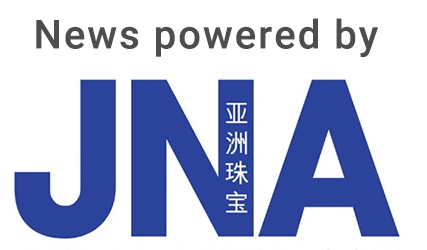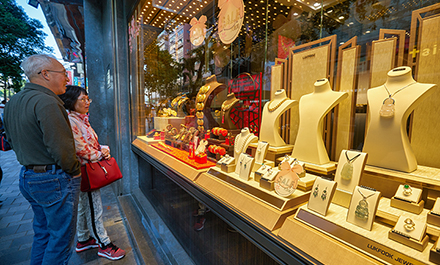The online jewellery market in China is thriving, thanks to the continued success of livestreaming, short-form videos and promotional events. More jewellers are expected to leverage the digital arena to drive growth and expand to overseas markets.
This article first appeared in the JNA September/October 2025 issue.
Momentum continues to build around China’s rising jewellery e-commerce trade, driven by tech-savvy younger consumers. Once dominated by brick-and-mortar stores, the country's jewellery business is thriving in major e-commerce platforms such as Tmall and Taobao, underscoring the effectiveness of livestreaming and digital marketing.
According to the 56th Statistical Report on China’s Internet Development released by the China Internet Network Information Center, Chinese online shoppers reached 976 million as of June 2025, accounting for 86.9 per cent of all Internet users there.
Meanwhile, the 2024 China Jewellery Industry Development Report by the Gems & Jewelry Trade Association of China showed jewellery e-commerce sales in the country reached RMB298.26 billion (around US$41.81 billion) in 2024, representing a year-on-year increase of 16.4 per cent.
The report highlighted an increasing number of jewellers venturing into livestream e-commerce. The combined online sales of five major jewellery hubs in China, namely Shuibei in Shenzhen, Ruili in Yunnan, Sihui in Guangdong, Pingzhou in Guangdong and Zhenping in Henan, exceeded RMB100 billion (around US$1.4 billion).
Pearl jewellery is one of the most popular e-commerce categories, thanks to its affordability and value for money. Jade and crystal are likewise gaining traction.
Speaking on the sidelines of Jewellery & Gem ASIA Hong Kong 2025, Rui Zi, senior operations manager of Chinese e-commerce giant Taotian Group (Alibaba’s e-commerce unit that includes Taobao and Tmall), said the volume of jewellery and accessories transactions on Tmall has been steadily recovering for three consecutive years, surpassing post-pandemic levels in 2022.
“This shows that consumer confidence is rebounding, and they are going online,” she said. “Primary consumers fall within the 25 to 39 age range. Most buyers hail from second- and sixth-tier cities, with an average transaction value ranging between RMB3,000 and RMB10,000 (approximately US$420 and US$1,400).”
Jewellery trends
An unprecedented surge in demand for gold alongside the popularity of emotional self-care jewellery and the rising appeal of minimalist styles are shaping China’s jewellery e-commerce landscape, according to 2025 Taotian E-commerce Jewellery Industry White Paper.
Gold jewellery captured the attention of younger generations, particularly those aged 18 to 24, who are drawn to its investment value as well as its traditional craftsmanship and innovative designs, Rui Zi explained.
Online discourse revolving around gold is fuelling heightened interest in gold jewellery, with trending social media topics such as “something timeless to wear” and “gold prices hitting new highs.”
Meanwhile, there was a significant increase in the popularity of crystal and gemstone pieces, reflecting the emergence of a “healing economy,” where consumers seek jewellery that provides emotional comfort and supports personal aspirations beyond mere adornment.
“People often believe that the jewellery they wear can attract good fortune, improve luck, health or career prospects,” said Rui Zi. “Consumers are gravitating towards motifs, and crystals like obsidian for protection or citrine for prosperity, blending cultural traditions and symbolic meanings.”
Another notable trend is minimalism. People are now embracing a more austere lifestyle, signalling a move towards quality and personal relevance above all. This shift in jewellery design preferences in favour of simplicity, quality and versatility caters to the desire for everyday lightweight and affordable pieces.
Empowering jewellers
According to the 2024 Tmall Store Opening Report, Tmall reported a 90 per cent year-on-year increase in the number of new jewellery stores in 2024. During their first year on the platform, 10 new stores achieved RMB100 million (around US$14 million) in sales while 90 new stores made over RMB10 million (around US$1.4 million).
“Tmall enables merchants to connect and engage with high-quality and high-value users who can drive business growth,” said Karl Huang, head of Tmall New Merchant Business of Taotian Group.
Well-established retail jewellers are venturing into Tmall to rejuvenate their brand image and eyeing a younger consumer segment, and designer brands are leveraging Tmall's extensive data resources for tailored positioning to reach new target audiences, Huang added.
Not all is rosy though as jewellery e-commerce also poses significant challenges. Shu Ta, senior operations manager at Taotian Group, identified pain points such as traffic acquisition, precise targeting of new customers with effective sales conversion and high product return rate.
“Leveraging top-tier e-commerce platforms like Taobao and Tmall, along with strategic store positioning, hosting livestreams, managing private traffic (a group of users with an established direct connection or relationship with a business or brand) and product innovation could build trust and enhance sales conversions,” said Ta.
Tmall's cutting-edge digital capabilities provide merchants with AI- and data-driven tools for customer segmentation and targeting, product insights, sales forecast, integrated digital media planning, market and competition analysis, and operational efficiency to help them understand and win over customers.
For luxury merchants, VIP programmes like 88VIP – now with 49 million members – facilitate engagement with high-value users, creating opportunities for brand expansion and fostering customer loyalty.
Tmall supports onboarded merchants and brands in achieving growth through its “Blue Star Project,” offering incentives and operational assistance. In 2025, Tmall rolled out an upgrade of the Blue Star Project, including incentives of up to RMB2.5 million (around US$350,169) per store, exclusive traffic channels to boost individual product growth, and 20 new benefits for novice merchants such as traffic support and reduced startup costs.
Growing opportunities
A key advantage of China’s e-commerce platforms is their ability to transcend geographical boundaries, connecting jewellers and consumers worldwide.
To help overseas jewellery brands effectively reach Chinese consumers, Taobao Global Shopping helps new merchants to establish their presence on Taobao through various incentive programmes like complimentary store setup, free traffic and cash rewards, revealed Ling Yin, head of global jewellery industry operations of Taotian Group.
“Jewellers are encouraged to follow Taobao’s annual marketing and sales events – including 618 and double 11 as well as global jewellery fairs and major livestreaming events – to maximise exposure, acquire new customers and drive repeat transactions,” she added.
Interestingly, there is a rising segment of high-value “Chinese media users” in Singapore, Malaysia and Thailand, according to a whitepaper titled “SEA of Change: The Rise of Chinese Media Users Redefining Modern Living and Consumer Power” conducted by EternityX.
Chinese media users comprise digitally native, high-spending consumers who navigate seamlessly between Chinese and local digital and media platforms, and whose behaviours are rapidly shaping retail, digital marketing and cross-border commerce. Among these countries, Thailand exhibits a strong preference for China-based cross-border e-commerce platforms, closely followed by Singapore.
The convergence of digital innovation, diverse consumer preferences and comprehensive platform support points to promising opportunities for jewellery merchants in China's rapidly expanding online marketplace.
What to watch: Leveraging e-commerce in China
Here are some pointers from Taotian Group executives aimed at helping jewellery merchants maximise success in online platforms:
• Optimise livestreaming: Regular, quality live content increases traffic, engagement and trust
• Emphasise transparency: Clear descriptions regarding product features and processing help foster credibility
• Data-driven insights: Use platform analytics and business advisors to target core audiences and identify category opportunities
• Leverage platform initiatives: Participate in marketing events and utilise incentive programmes
• Cultural relevance: Align store positioning and product offerings with consumer trends – gold, “healing jewellery,” minimalism and new Chinese styles













